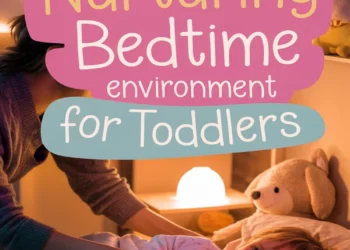Helping your child shift to their own bedroom can be both exciting and nerve-wracking for both of you. Be sure to create a calming environment with soft lighting and familiar items, and involve your child in the decoration process. Establish a consistent bedtime routine and address any nighttime fears by validating their feelings. This encourages independence and ownership. There’s so much more to explore that can ease this shift for both you and your little one.
Understanding the Emotional Impact of Transitioning
When your child moves to their own bedroom, it’s important for both of you to experience a mix of emotions. You might feel proud of their growing independence, yet hesitant about letting go. Your child, too, may feel excited but anxious about the change. It’s crucial to acknowledge these feelings openly. Talk to your child about what they’re experiencing; validate their worries and celebrate their achievements. Remind them that it’s okay to feel scared or lonely at first. Reassure them of your support and nearby presence, emphasizing that this shift is a positive step in their development. By fostering open communication and understanding, you’ll help both of you navigate this significant milestone with confidence and comfort.
Preparing the Bedroom Environment
As your child adjusts to their new bedroom, creating a comforting environment can help ease their feelings of anxiety and excitement. Start by choosing soft lighting, like a nightlight, to create a calming atmosphere. Incorporate familiar items, such as their favorite stuffed animals or blankets, to give them a sense of security. Choose soothing colors for the walls or bedding that foster relaxation. Additionally, consider arranging the furniture in a way that allows for an open, inviting space. You might add personal touches, like framed photos or wall art, to make it feel truly theirs. Finally, keep the room tidy and organized, ensuring it remains a peaceful refuge for sleep and comfort as they navigate this change.
Involve Your Child in the Process
Involving your child in the shift to their own bedroom makes the process smoother and more exciting for them. When you engage your child in this change, you’re allowing them to express their preferences and take ownership of their new space. Start by discussing colors, themes, or decorations together. Let them choose a few items that reflect their personality.
- Encourage them to pick out bedding they love.
- Let them help rearrange furniture to their liking.
- Ask for their input on organizing toys or books.
Recommended Items
Here are our top picks to make your child’s transition to their own bedroom smooth and enjoyable—explore these essentials!
Establish a Consistent Bedtime Routine
Creating a consistent bedtime routine is essential for helping your child feel secure and comfortable in their new bedroom. Start with calming activities that signal it’s time to wind down. Consider a warm bath, followed by reading a favorite story. This not only fosters closeness but also sets a predictable pattern your child can rely on. Aim to start this routine at the same time each night; consistency reassures your child that bedtime is approaching. Encourage them to express their feelings, whether it’s excitement or anxiety, as you navigate this change together. Remember, this familiarity will help your child associate their bedroom with safety and peace, making their new space a comforting haven for restful sleep.
Gradual Transition Techniques
To guarantee your child feels comfortable in their new bedroom, try implementing gradual change techniques that ease the process for both of you. Start by allowing your child to spend short periods in their own room during the day, gradually increasing this time. You might also consider sleeping in their room until they feel secure enough to fall asleep alone. Finally, try making the shift fun by involving them in arranging their new space with their favorite items.
- Create a cozy sleep environment with soft lighting and favorite colors.
- Read bedtime stories together in their new room to create positive associations.
- Use a reward system to celebrate small successes in their change.
These steps can help make the change smoother and comforting.
Use Comfort Objects for Security
Many children find comfort in familiar objects during times of change, so using comfort items can be a powerful tool to help your child feel secure in their new bedroom. Consider letting your child pick a special blanket, stuffed animal, or small keepsake to bring along. These items can create a sense of safety, reminding them of home and the love surrounding them. You might also establish a bedtime routine that incorporates these comfort objects, helping your child wind down and associate their new space with positive feelings. Encourage them to share stories about their chosen items, fostering an emotional connection that can ease their adjustment. With patience and reassurance, comfort items will help your child navigate this exciting new chapter.
Step-by-Step Guide to Bedroom Transition
Addressing Nighttime Fears
Nighttime fears can be an intimidating experience for children moving to their own bedroom, often manifesting as anxiety when the lights go out. It’s crucial to validate their feelings and reassure them that it’s okay to be scared. Here are a few strategies to help ease their fears:
- Encourage Open Dialogue: Let them express their worries, and listen without judgment. Sometimes, just talking about their fears can reduce anxiety.
- Create a Calming Routine: A consistent bedtime routine can provide comfort. Consider reading a calming story or playing soft music before sleep.
- Use Night Lights: A night light can make a big difference. It adds a comforting glow that helps them feel more secure in their new space.
Celebrate the Move With a Special Event
Shifting to their own bedroom is a big step for your child, and celebrating this milestone can make the experience more exciting and memorable. Consider throwing a small celebration, like a family movie night in their new room. Allow your child to pick a favorite film, create a cozy atmosphere with blankets and snacks, and let them feel the joy of their new space. You could also add a special touch by giving them a small gift, like a nightlight or a favorite book to read at bedtime. Sharing this moment together creates a positive association with their new environment, reinforcing that their individuality is valued. This encouragement helps ease anxieties and highlights the fun that comes with this new adventure.
Encourage Independence and Ownership
As your child settles into their new bedroom, fostering a sense of independence and ownership becomes essential for building their confidence. Allow them to personalize their space with their favorite colors, decorations, or toys. Encouraging decisions about their room promotes autonomy and lets them feel more invested in it.
Here are a few ways to inspire that sense of independence:
- Let them choose bedding or wall art to reflect their personality.
- Involve them in organizing their space, so they learn how to keep it tidy.
- Encourage a bedtime routine that they can manage, reinforcing their ability to take charge.
Monitor Progress and Provide Reassurance
While your child adjusts to their new bedroom, it’s important to monitor their progress and provide the reassurance they need. Check in regularly, and ask open-ended questions about how they feel during this shift. If they express fears or concerns, listen empathetically and validate their feelings. Share encouraging words to remind them it’s okay to be uncertain and that they’re safe in their space. Celebrate small victories, like sleeping in their room alone for the first time, to build their confidence. You might also consider creating a bedtime routine that includes extra cuddle time or stories together. This way, they’ll feel more secure, and you’ll foster a strong bond as they navigate this important change.













